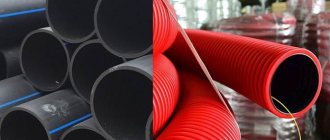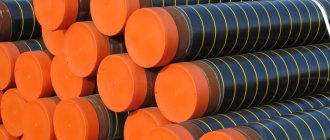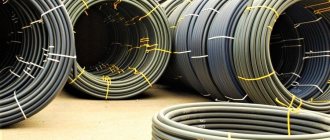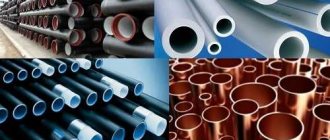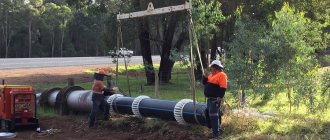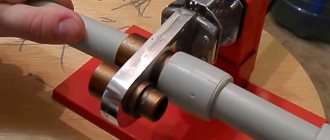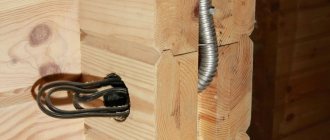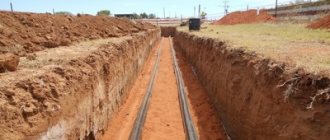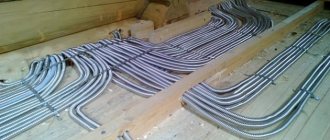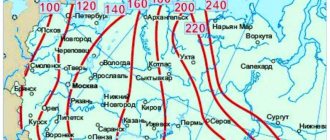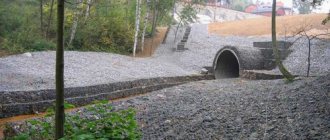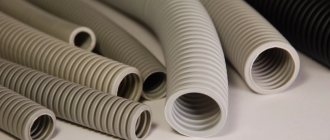Laying them in pipes allows you to reduce the cost of cable products and reduce labor costs for replacing existing cables. The production of such pipes is regulated by GOST R IEC 61386-2104 and GOST R IEC 61386.24-2014.
HDPE pipe for cable protection has the following properties:
- long (over 50 years) service life;
- corrosion resistance;
- light weight;
- greater flexibility;
- ease of installation;
- large range of components.
Scope of application:
- laying cable communications along and under highways, railways, landing strips at airports;
- protection against damage to power cables, telecommunications, outdoor advertising and street lighting.
The POLIPLASTIC group offers the ELECTROKOR and ELECTROPIPE series, designed to fulfill these purposes, as well as protective polyethylene pipes (PPP) for linear communication structures.
ELECTROKOR
Flexible pipe products with corrugated wall. High reliability is achieved through optimization of the wall profile and the use of special composite materials. Operate at temperatures from -55 to +90°C.
ELECTROCORE LITE
Single-layer pipes for low-current cables and low voltage underground from possible mechanical damage without transport loads. Mounted with a coupling connection with or without an O-ring.
ELECTROKOR FLEX
Double-layer pipe products protecting low- and medium-voltage power cables, as well as low-current ones.
ELECTROKOR
Double-layer pipes with improved strength characteristics, designed to protect cable networks under conditions of increased transport load.
ELECTROKOR PRO
Two-layer products with the highest strength characteristics for laying high, medium and low voltage cable networks under high transport loads.
Popular diameters (Table)
When purchasing HDPE pipes, you need to be guided by the outer diameters and wall thickness. These parameters determine the scope of application of the products.
Risers with a cross-section from 16 to 63 mm are indispensable when laying electrical cables in buildings and in the ground.
Parts with a diameter of 50-75 mm are suitable for arranging waste systems for bathtubs, washing machines, and sinks. Cables from lamp posts and wires along roads are placed in them.
Almost most of us have dealt with pipes with a diameter of 110 mm, since they are used for sewer lines. Electrical and fiber optic structures are placed in such pipe elements.
Among the risers of large diameters, parts with a cross section of 400, 800, 1000, 1200, 1600 mm stand out. The construction of storm and sewer collectors, pressure water pipelines, drainage mains is the scope of application of such risers.
It is often necessary to know how much an HDPE pipe weighs. This is due to the fact that it is necessary to calculate in advance the mass of the suspended sewer system and the structure for laying electrical communications.
The table shows how much 1 meter of HDPE pipe weighs, depending on the outer diameter and SDR value.
Calculated weights of popular polyethylene pipes made of PE-63, PE-80, PE-100
| HDPE 100 | The magnitude of possible pressures, kPa | ||||||
| External diameter, mm | 600 | 850 | 950 | 1000 | 1250 | 1600 | 2000 |
| Wall thickness, mm | |||||||
| 16,00 | — | — | — | — | — | — | 2,00 |
| 20,00 | — | — | — | — | — | 2,00 | 2,30 |
| 25,00 | 2,00 | 2,30 | 2,80 | ||||
| 32,00 | — | — | — | 2,00 | 2,40 | 3,00 | 3,60 |
| 40,00 | — | 2,00 | — | 2,40 | 3,00 | 3,70 | 4,50 |
| 63,00 | 2,50 | 3,00 | 3,60 | 3.80 | 4,70 | 5,8 | 7,10 |
| 90,00 | 3,50 | 4,30 | 5,20 | 5,40 | 6,7 | 8,20 | 10,10 |
| 125,00 | 4,80 | 6,00 | 7,10 | 7,40 | 9,20 | 11,40 | 14,00 |
| 160,00 | 6,20 | 7,70 | 9,10 | 9,50 | 11,80 | 14,60 | 17,90 |
| 200,00 | 7,70 | 9,60 | 11,40 | 11,90 | 14,70 | 18,20 | 22,40 |
| 225,00 | 8,60 | 10,80 | 12,80 | 13,40 | 16,60 | 20,50 | 25,20 |
| 250,00 | 9,60 | 11,90 | 14,20 | 14,80 | 18,40 | 22,70 | 27,90 |
Advantages of two-layer heat-resistant HDPE pipes made in accordance with GOST R IEC.
- Long service life reaches 50 years.
- Do not corrode
- Convenience and ease of installation.
- Wide selection of components and connecting parts.
- In case of fire, the pipes do not release harmful substances.
- Cable protection from mechanical damage
- Red marker color simplifies damage control and identifies networks
- Double-layer pipes, thanks to the possibility of laying using the HDD method, simplify the installation or replacement of cable systems within the city. Allows you to limit traffic only partially and quickly restore the road surface, only in puncture areas. Which also saves the budget.
Polymer cable protection systems
Types of cable protection pipes from the ENERGOPLAST plant
COMPLIANCE OF CHARACTERISTICS OF TZK ENERGOPLAST® PIPES WITH REGULATORY DOCUMENTATION
| Requirements for heat-resistant protective cable pipes | Compliance of TZK ENERGOPLAST® pipes | ||||
| Indicator name | Norm | BC | TS | TS2 | TS3 |
| Requirements for tightness of connections | IP68 | ||||
| Tensile yield strength, MPa, not less | 21 | ||||
| Elongation at break, %, not less | 350 | ||||
| Chemical resistance | Good resistance to sulfuric acid 40% | — | — | ||
| Tensile modulus of elasticity, MPa, not less | 850 | ||||
| Hardness Shore D, not less | 66 | ||||
| Impact test | No cracks or other damage | ||||
| Change in pipe length after heating, %, no more | 3 | ||||
| Thermal conductivity, W/(m K), not less | 0,5 | ||||
| Resistance to open flame* | Category FV-0 (PV-0) | — | — | ||
| Test for resistance to ignition with a heated wire at a temperature of (960±15)°C* | No open flame or combustion and the sample glows for no more than 30 s after eliminating the ignition source | — | — | ||
| Heat resistance (75°C)* | The diameter of the ball print should not exceed 2 mm | — | — | ||
| Thermal stability at 200°C, min, not less | 200 | ||||
| UV resistance | No cracks or other damage | ||||
| Test to confirm climatic performance | Preservation of physical and mechanical parameters under specified environmental conditions | — | |||
* only for the inner layer of pipes TZK ENERGOPLAST® TS2 and TZK ENERGOPLAST® TS3 (according to GOST R 53313)
Normative documents:
- STO 34.01-21.1-001-2017 – Organization standard of PJSC Rosseti. Electrical distribution networks with voltage 0.4-110 kV. Requirements for technological design.
- STO 34.01-2.3.3-037-2020 - Organization standard of PJSC Rosseti. Pipes for laying cable lines with voltages above 1 kV. Methodology for incoming inspection at electrical grid construction sites.
- Regulations of PJSC Rosseti “On a unified technical policy in the electric grid complex.”
- GOST R 53313 — Molded electrical installation products. Fire safety requirements. Test methods.
- Technical requirements of Rosseti PJSC for smooth, heat-resistant polymer pipes of the grade for laying power cables, subject to verification during certification in accordance with regulatory and technical documentation.
Multilayer cable pipes have a monolithic homogeneous structure in which the layers are connected at the pipe formation stage by molecular mixing under the influence of temperatures. Thus, pipe delamination during production, installation and operation is completely eliminated.
Mechanical or chemical damage to the wiring can cause a lot of problems: from a sudden loss of connection to the worldwide network, to short circuits that can damage all equipment. Therefore, the issue of protecting wires from physical stress, mechanical damage and environmental influences becomes paramount. And if a dozen years ago, pipes for protecting cables were made of metal or concrete, which created certain difficulties during operation, transportation and increased the cost of installation, today they are made of low-density polyethylene. Multilayer heat-resistant cable pipes made of special composites with increased thermal conductivity are especially relevant.
The use of such innovative materials has made it possible to reduce costs associated with installation and get rid of the disadvantages inherent in “early” analogues. It is worth noting that with the advent of smooth HDPE pipes for cables, service life has increased significantly, and installation costs have decreased several times due to:
- convenience and ease of installation due to flexibility and light weight;
- the ability to use less expensive cable products and replace cables with less labor;
- high reliability of connections;
- constant tightness throughout the entire service life (from 50 years);
- resistance to any loads (static and dynamic);
- application of any installation methods, including trenchless;
And thanks to its high strength, good resistance to aggressive chemical environments, amazing frost resistance and the ability to withstand heavy loads, this protection option has become a priority.
In what cases should HDPE pipes be used to protect cables?
The cable protection pipe is used when laying power or fiber-optic communication lines:
- In the ground;
- Inside solid, plastered walls;
- In monolithic concrete structures.
Considering that the pipe has smooth internal surfaces, cable installation occurs quickly, without the need for additional equipment or tools. It is worth noting that due to the characteristics of the material, you can carry out prompt repairs in places where the wiring is damaged without the need to completely dismantle the protective pipe.
Why is it recommended to use polyethylene pipes when laying wiring in the ground?
Firstly, the material has high strength, providing reliable protection of wires from mechanical damage under physical stress. In other words, the use of protective polymer pipes eliminates the possibility of rupture and provides additional safety for the wiring for the entire period of its operation.
Secondly, low-pressure polyethylene pipes are resistant to aggressive chemicals contained in groundwater. Consequently, the cable will be protected from destruction of current-carrying cores or light-conducting fibers.
Thirdly, the unique properties of the material ensure a long service life: subject to the correct transportation and installation conditions, the protective properties of the pipe are not lost for 50 years or more!
Use when installing cable ducts
Laying cable ducts simplifies, speeds up and reduces the cost of the construction process. The system consists of one or more pipes interconnected and laid together with all life support systems before construction begins. In this case, power cables and optical fiber will be laid inside existing channels underground, which simplifies further operation and maintenance of networks, because if it is necessary to replace wires that have served their purpose, the service company will not have to carry out excavation work, destroy the road surface, etc.
In this case, the protection of cable communication lines plays an important role, because The further performance characteristics of the entire system depend on the strength of the materials used. And HDPE pipes are the best solution, because... have maximum reliability in comparison with analogues from other materials.
Is it possible to use HDPE pipes to protect electrical wiring?
Their high strength and heat resistance make them the best insulating material when laying cables in the ground.
The popularity of this method of protection is due to the possibility of connection and/or extension by welding. The welds are absolutely sealed and have greater strength than the pipes themselves. In addition, there are varieties with an inner layer that does not support combustion in the event of an emergency and prevents the cable from being soldered to the pipe in the event of a short circuit.
Pipes for protecting cable lines from the ENERGOPLAST plant
Over several years of active activity in the Russian market, the Energoplast pipe plant has managed to earn the trust of customers by offering quality products at an adequate, affordable price. With our own production, advanced material and technical equipment and access to premium materials, we can offer:
- Large range of protective HDPE pipes;
- Constant availability of goods in the company’s warehouses;
- Possibility of manufacturing “specific” products to order;
- Multi-level quality control of finished products;
- Compliance with domestic GOSTs and international standards;
- Full package of accompanying documentation;
- Cooperation under an agreement fixing the terms and cost of the order;
- Fast delivery of products throughout Russia and the CIS countries;
- Comfortable payment terms, flexible payment schemes.
You can get additional information, clarify the terms of cooperation and order the necessary products:
- On the site;
- Through the “feedback” form;
- At the company office;
- By phone and email.
Managers of ENEGOPLAST LLC welcome everyone and are ready to answer all questions in any format convenient for you!
TZK ENERGOPLAST heat-resistant pipes fully comply with the requirements of the standard of PJSC Rosseti (STO 34.01-2.3.3-037-2020), which is confirmed by the accreditation of a number of Russian electric grid companies.
Helpful information
STO 34.01-2.3.3-037-2020 “PIPES FOR LAYING CABLE LINES WITH VOLTAGES ABOVE 1 kV”
GOST 18599-2001 as amended. 1.2 “Polyethylene pressure pipes. Specifications (with Amendment, with Changes No. 1, 2)"
GOST R 58121.2-2018 “Plastic pipelines for transporting gaseous fuels. Polyethylene (PE) Part 2. Pipes"
Laying cable in a pipe under the road
In some situations, it is necessary to lay the cable under the road. This is a rather difficult method, which is used if it is impossible to dig a trench. A specialized organization that has the necessary equipment will be able to handle the drilling.
When choosing pipes, it is necessary to take into account the load that will be placed on them. If you plan to lay the cable under the road, near houses or industrial facilities, then it is best to choose the most durable products.
You must fully follow the installation rules. In this case, the cable will be maximally protected from environmental influences, and the HDPE pipe will not wear out prematurely.
